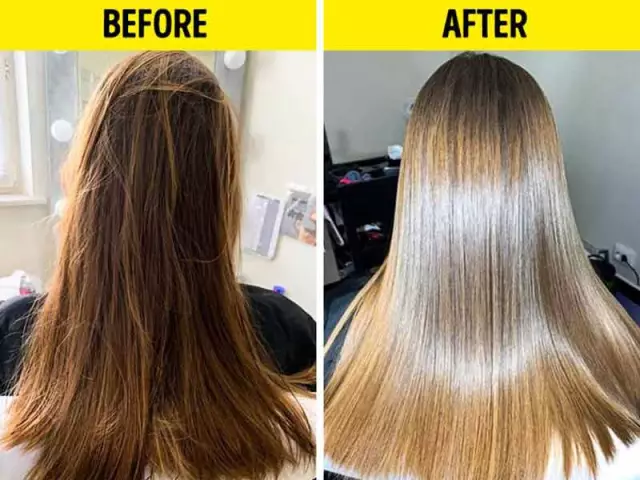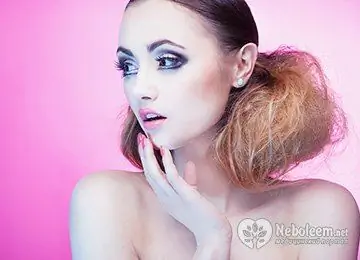- Author Rachel Wainwright [email protected].
- Public 2023-12-15 07:39.
- Last modified 2025-11-02 20:14.
Hair
People have always attached great importance to the appearance of their hair. And this is not surprising! After all, well-groomed beautiful hair is evidence of good physical health and a calm psycho-emotional state. And vice versa - dull brittle hair speaks of many problems in a person's life.

Hair structure
Hair is one of the appendages of the skin and is formed from the outer layer of the skin (epidermis). There are several types of hair:
- Cannon - their length does not exceed 1.5 mm. They can be observed on any part of the human body, with the exception of the surface of the feet and palms.
- Bristly or short. This group includes hair growing at the edge of the nostrils, forming the eyebrows and eyelashes.
- Long hair - This includes hair growing on the head, genitals, shoulders, chest and beard.
Each hair consists of the following parts:
- Stem - located above the skin surface;
- Root;
- Hair follicle.
97% of hair consists of a solid protein substance enriched with vitamins and microelements - keratin and 3% of water.
Hair grows about half a millimeter during the day and is the fastest growing organ. Each hair has an average lifespan of two to six years. Every day, an adult falls out about 80 hairs, and new ones begin to grow in their place.
On the human head, there are from 60 to 500 thousand hairs. Red-haired people have the least amount of hair. The thickest hair is found in brunettes, while in blondes it is usually quite thin.
Healthy hair has a high strength comparable to that of aluminum. On average, one hair can withstand a load of about 20.0 grams.
Hair loss
As we said above, each person loses about 80 hairs per day. This is a normal physiological process. But sometimes hair loss can become significant. As a result, hair becomes thinner and, in severe cases, even baldness (alopecia) can develop.
The causes of hair loss can be very different:
- Hereditary predisposition;
- Aging process;
- Hormonal disorders;
- Hair damage (perm, drying, coloring, etc.);
- Traumatic damage to the scalp;
- Autoimmune diseases;
- Fungal and bacterial infections;
- Certain medications (chemotherapy drugs, anticoagulants, etc.)
- Radiation;
- Stress;
- Diseases of the thyroid gland;
- Wrong hairstyles (too tight tails, braids);
- Poor nutrition.
Hair loss can be complete (falls out evenly over the entire head) or local (partial).
Hair treatment for alopecia is largely determined by the cause that caused the development of this condition. If the disease is associated with a hereditary predisposition or an age factor, then it is almost impossible to stop its further progression. However, with proper hair care, hair loss can be significantly reduced. To do this, use special hair products (shampoos, balms, conditioners). For combing, the best choice is a wide-toothed comb. Try not to dye your hair, perm, and use a hairdryer as little as possible.
The over-the-counter drug Minoxidil can also help you with hair loss. With its regular use, about a third of patients manage to restore their hair. However, after the end of the course of treatment, hair often begins to fall out again.
Pay attention to your diet too. Healthy, strong and beautiful hair cannot be found in people who are undernourished. The diet should be balanced in protein, carbohydrate and fat content. You should eat fresh vegetables and fruits every day.
If hair loss is related to other causes, then a doctor's consultation is necessary. Only a doctor will be able to establish the exact cause of the disease and prescribe a full-fledged hair treatment aimed at eliminating the cause of hair loss. In the absence of the effect of the therapy, hair transplantation can be performed.
Hair products
Advertising for various hair products promises "silky, thick and beautiful hair." But in fact, it often happens that by choosing a shampoo that is not suitable for a particular type of hair, we are faced with a completely opposite effect.
The main function of any shampoo is to wash away grease and dirt from the hair. In addition, it should give our hair shine, elasticity, elasticity, silkiness. A good quality shampoo helps to retain moisture in the hair shaft and also nourishes the scalp.
Shampoo for oily hair contains microspheres and microsponges. The former nourish the ends of the hair, while the latter perfectly remove the layer of fat from the root zone.
For dry hair, you should choose restorative and nourishing shampoos containing vitamins, plant extracts and oils, collagen and proteins. Such shampoos moisturize the scalp well, restore the structure of the strands. With their regular use, you will get luxurious and beautiful hair.
For those with normal hair, it is best to opt for a mild shampoo with a low content of nourishing and drying components.
All other hair products (balms, conditioners, styling foams, etc.) should be chosen, also focusing on your natural hair type.
Found a mistake in the text? Select it and press Ctrl + Enter.






